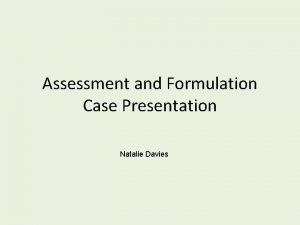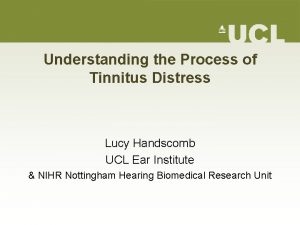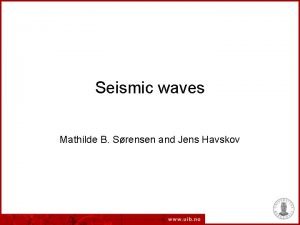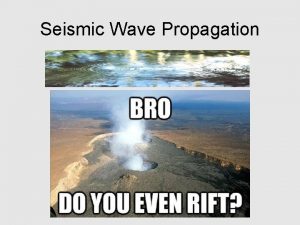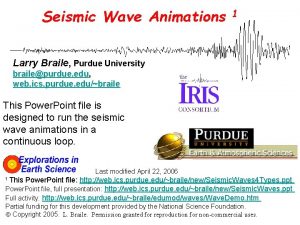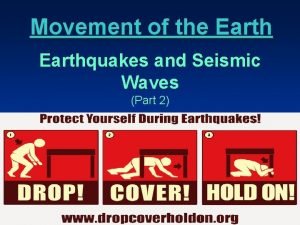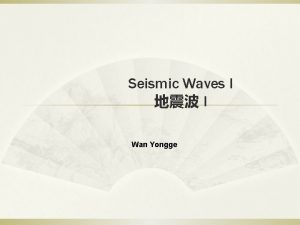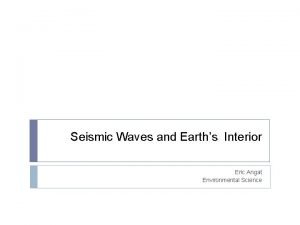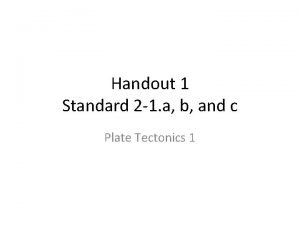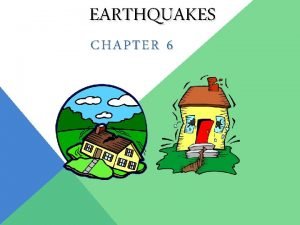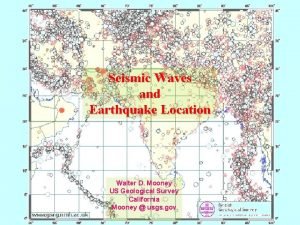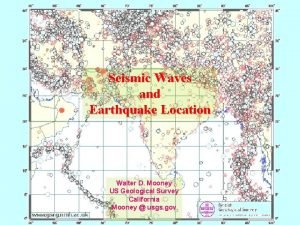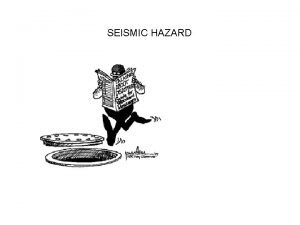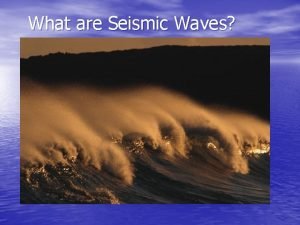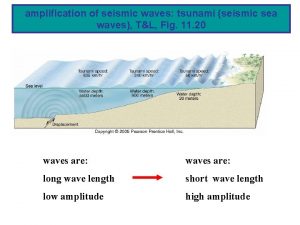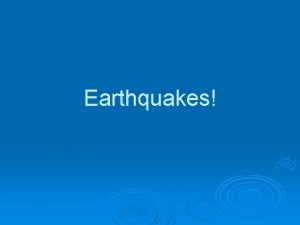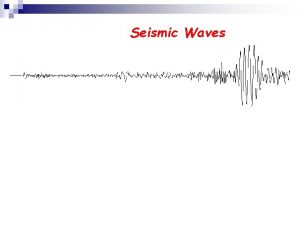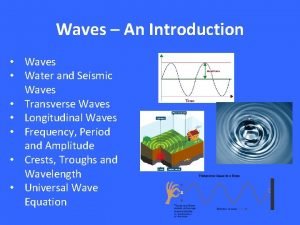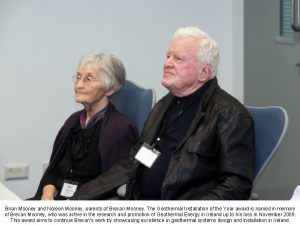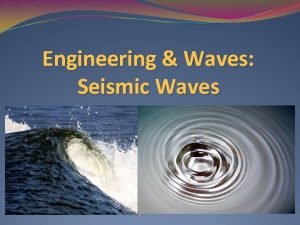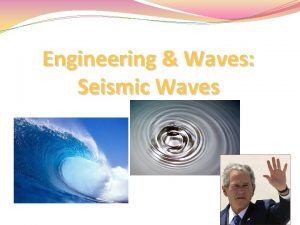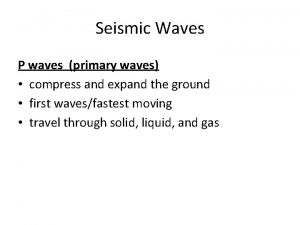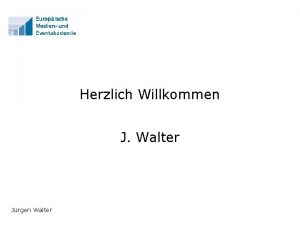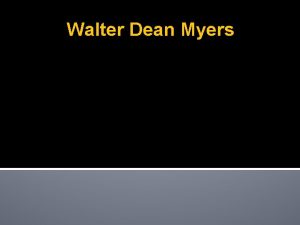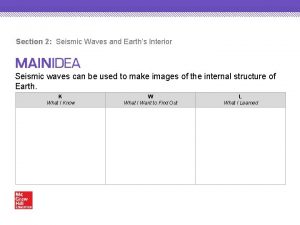Seismic Waves An introduction Walter D Mooney USGS





























- Slides: 29

Seismic Waves An introduction Walter D. Mooney, USGS Menlo Park, CA.

What is an Earthquake? • Instrumentally recorded (or felt) ground shaking, normally a result of underground movement on a fault Seismogram of the 1906 earthquake recorded in Germany San Francisco 1906 (USGS)

Faulting Seismic waves USGS

Types of Seismic Wave Three-components of a seismometer record proportional to ground velocity of the P and S waves from a local aftershock of the Killari -Latur EQ, India (1993), at a hypocentral distance of 5. 3 km P. Bormann. 2002. New Manual of Seismological Observatory Practice (NMSOP)

Body Waves P. Bormann, NMSOP Bulk modulus = P / ( V/ V) Shear modulus or „rigidity“ = ( F/A) / ( L/L) Young´s or „stretch“ modulus E = (F/A)/ ( L/L) and Poisson ratio = ( W/W) / ( L/L) Deformation of material samples for determining elastic moduli Copyright 2004. L. Braile.

Particle motion of body waves 4. 5 s 1 s 3 -component records at station MOX (top traces) and related plots of particle motion in the horizontal (N - E) plane and two vertical planes (Z - N and Z – E, respectively) of the P- wave onset from seismic event (mining collapse) in Germany (1989; Ml = 5. 5; epicentral distance D = 112 km, back-azimuth BAZ = 273°). Left: broadband recording (0. 1 – 5 Hz); right: filtered short-period recording (1 – 5 Hz). Note: The incidence angle is 59. 5° for the long-period P- wave oscillation and 47. 3° for the high-frequency P-wave group. P. Bormann (NMSOP)

Surface Waves – Form at the free surface – Amplitude decays exponentially with depth. Copyright 2004. L. Braile.

January 26, 2001 Gujarat, India Earthquake (Mw 7. 7) Rayleigh Waves vertical radial Love Waves transverse Recorded in Japan at a distance of 57 o (6300 km) Courtesy J. Mori

Wave Period and Wavelength Velocity 6 km/s Space x wavelength Time wavelength 300 km t period 50 s frequency = 1/period= 0. 02 Hz period Velocity = Wavelength / Period Courtesy J. Mori

Period Wavelength Body waves 0. 01 to 50 sec 50 m to 500 km Surface waves 10 to 350 sec 30 to 1000 km Free Oscillations 350 to 3600 sec 1000 to 10000 km Static Displacements - Courtesy J. Mori

Other phases Digital broadband record of the Seattle Mw = 6, 8 earthquake on 28 February 2001 at the station Rüdersdorf (RUE) in Germany (epicentral distance D = 73°). Note the detailed interpretation of secondary phase onsets. P. Bormann (NMSOP)

Ray theory • Seismic waves can be represented as rays

Ray Paths in a Layered Medium sin q 1 / a 1 = sin q 2 / a 2 = s 1 sin q 1 = s 2 sin q 2 a = velocity of seismic energy in the layer a 1 a 2 q 1 slower q 2 a 1 < a 2 Faster a 1 a 2 Faster q 1 q 2 Slower a 1 > a 2 Courtesy J. Mori

Ray Paths in a Layered Medium Time 1/a 3 1/a 2 1/a 1 Distance a 1 a 2 a 3 Courtesy J. Mori

The Moho Andrija Mohorovicic (1857 -1936) Found seismic discontinuity at 30 km depth in the Kupa Valley (Croatia). Mohorovicic discontinuity or ‘Moho’ Boundary between crust and mantle The Moho Copywrite Tasa Graphic Arts

Structure in the Earth results in complicated paths Lowrie, 1997, fig 3. 69 USGS Bolt, 2004, fig 6. 3

Propagation of Seismic Waves In the Earth; M. Wysession

Courtesy R. Mereu Courtesy J. Mori

Courtesy J. Mori

Forward Branch Backward Branch Courtesy J. Mori

Forward Branch Shadow Zone Forward Branch Backward Branch Courtesy J. Mori

Pc. P Backward Branch Forward Branch Shadow Zone PKP Forward Branch Pc. P P Shadow Zone Forward Branch Backward Branch Forward Branch ・ 1912 Gutenberg observed shadow zone 105 o to 143 o ・ 1939 Jeffreys fixed depth of core at 2898 km (using Pc. P) Courtesy J. Mori

Pc. P Core Reflections Courtesy J. Mori

P Mantle P S Mantle S K Outer core P I Inner core P c Reflection from the outer core i Reflection from the inner core Diffracted arrival diff IASP 91, Kennett and Engdahl, 1991

Stacked broadband seismograms for shallow earthquakes. Seismic phases are shown in different colors: Blue = vertical Green = radial horizontal Red = transverse horizontal P. Bormann. 2002. New Manual of Seismological Observatory Practice (NMSOP)

Amplitude and Intensity Seismic waves lose amplitude with distance traveled - attenuation A(t) = A 0 e -ω0 t/2 Q So the amplitude of the waves depends on distance from the earthquake. Therefore unlike magnitude intensity is not a single number.

Normal Modes Liberty Bell (USA) l=1 m=1 Useful for studies of ・ Interior of the Earth ・ Largest earthquakes l=1 m=2 l=1 m=3 Houseman http: //earth. leeds. ac. uk/~greg/? Sphar/index. html

Toroidal and Spheroidal Modes Toroidal Spheroidal Dahlen and Tromp Fig. 8. 5, 8. 17

Natural Vibrations of the Earth Shearer Ch. 8. 6 Lay and Wallace, Ch. 4. 6
 Seismic waves are mechanical waves
Seismic waves are mechanical waves Hot cross bun model
Hot cross bun model Padesky and mooney 1990
Padesky and mooney 1990 Mooney 305 rocket
Mooney 305 rocket Cual es la sexta regla del manual de mooney
Cual es la sexta regla del manual de mooney Seismic
Seismic Seismic waves
Seismic waves Seismic waves
Seismic waves P wave animation
P wave animation What are the three types of seismic waves
What are the three types of seismic waves Seismic waves
Seismic waves Text book
Text book Which seismic waves stay on earth's surface
Which seismic waves stay on earth's surface Seismic waves
Seismic waves Earthquake waves
Earthquake waves Four types of seismic waves
Four types of seismic waves Whats the main cause of earthquakes
Whats the main cause of earthquakes Mechanical waves and electromagnetic waves similarities
Mechanical waves and electromagnetic waves similarities Sound waves are longitudinal waves true or false
Sound waves are longitudinal waves true or false What are the mechanical waves
What are the mechanical waves Differences between mechanical and electromagnetic waves
Differences between mechanical and electromagnetic waves Characteristics of a longitudinal wave
Characteristics of a longitudinal wave Sound waves longitudinal waves
Sound waves longitudinal waves What is a semiconductor used for
What is a semiconductor used for Difference between matter waves and electromagnetic waves
Difference between matter waves and electromagnetic waves Mechanical waves vs electromagnetic waves
Mechanical waves vs electromagnetic waves Mechanical waves and electromagnetic waves similarities
Mechanical waves and electromagnetic waves similarities Compare and contrast p waves and s waves using venn diagram
Compare and contrast p waves and s waves using venn diagram Electromagnetic and mechanical waves
Electromagnetic and mechanical waves Differences between constructive and destructive waves
Differences between constructive and destructive waves

